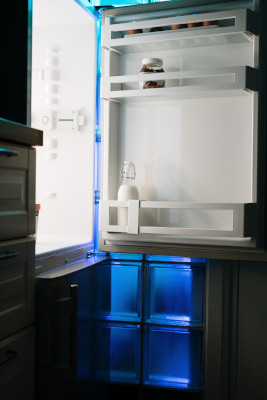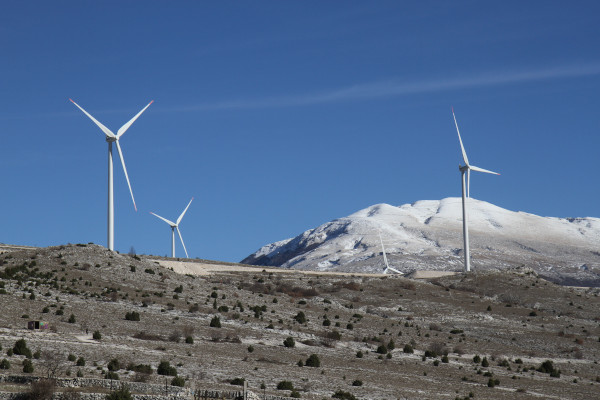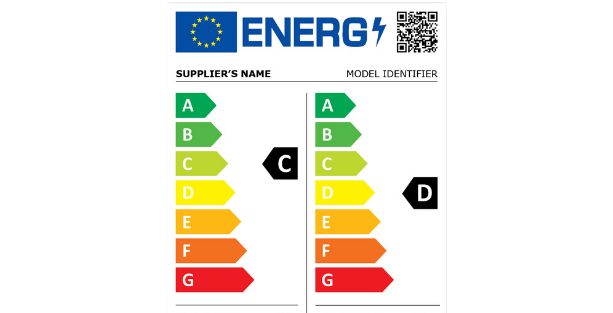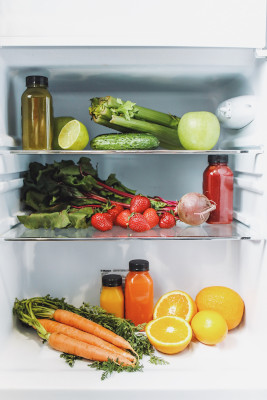Energy-Efficient Fridges: What You Need to Look Out For
Energy prices are out of control and everybody wants to save money any way they can.
Whether it be turning all electrical appliances off at the wall when not in use, to replacing old appliances with more energy-efficient ones.

According to Which’s research, the average house could say up to £3,360 over 10 years by switching to energy-efficient appliances.
Fridges are no different – in fact, it’s more important to have an energy-efficient fridge than any other appliance. Why? Because fridges are plugged in and are switched on 100% of the time.
But what do you need to look for in an energy-efficient fridge? How do you decide which is the best?
Great questions – let’s take a look at some answers.
What is Energy Efficiency?

First, let’s grapple with what is actually meant by energy efficiency.
Energy-efficient refers to the ability of a device or system to accomplish a desired task while minimizing energy consumption.
For fridges, an energy-efficient model is designed to use less energy to perform its cooling functions compared to standard or less efficient models.
The concept of energy efficiency focuses on maximizing the output or performance achieved per unit of energy input.
Energy-efficient appliances are engineered to minimize energy waste, reduce energy consumption, and lower greenhouse gas emissions associated with energy production.
Energy Rating
In the UK, the fridge will have an energy rating label attached to it. This will indicate exactly how energy-efficient the fridge actually is and will look a little something like this:

Label Origins
The labels are mandatory as part of the EU’s Energy Labeling Regulations, which aim to reduce energy consumption and promote the use of renewable energy.
Despite the UK no longer being in the EU, we have opted to use these regulations as part of its own energy efficiency policies regardless.
So now that we know about energy-efficiency labels, let’s get down to the cold, hard numbers of it all.
Size and Capacity
Choose a fridge size that matches your needs to avoid excessive energy consumption.
Larger fridges generally consume more energy, so select an appropriate size for your household.

When it comes to the size and capacity of an energy-efficient fridge, there are a few factors to consider in order to strike the right balance. Here’s what you should keep in mind:
- Household Size: The size of the fridge should align with the number of people in your household. Larger households typically require more storage space, while smaller households can manage with a smaller fridge. Consider the number of family members and their food storage needs.
- Food Consumption Habits: Assess your food consumption habits to determine the appropriate fridge capacity. If you frequently buy groceries in bulk or store large quantities of fresh produce, you may need a larger fridge. On the other hand, if you tend to buy smaller quantities or prefer more frequent grocery trips, a smaller fridge might suffice.
- Available Space: Measure the space in your kitchen or designated area where you plan to install the fridge. Consider the height, width, and depth to ensure a proper fit. It’s important to choose a size that not only meets your storage needs but also fits comfortably within the available space.
- Energy Efficiency and Size: Generally, smaller fridges tend to be more energy-efficient compared to larger ones. This is because larger fridges require more energy to cool and maintain the desired temperature due to their greater interior space. Thus, selecting a fridge that meets your needs without excessive extra space can help optimize energy usage.
- Additional Cooling Options: If you find that your storage needs exceed the capacity of a single fridge, consider supplementing it with a separate freezer or a secondary fridge. This way, you can optimize energy usage by selecting smaller, specialized appliances for specific storage requirements.
Energy Consumption Rating
The energy consumption rating of a fridge is an important factor to consider when looking for an energy-efficient model.
This rating indicates the amount of energy the fridge is expected to consume over a year of typical use and is typically expressed in kilowatt-hours (kWh) per year.

When comparing energy consumption ratings, lower numbers indicate higher energy efficiency. A lower energy consumption rating means that the fridge uses less electricity to perform its cooling functions, resulting in potential cost savings on your energy bills.
The energy consumption rating is typically provided by the manufacturer and can be found on the fridge’s energy label or in the product specifications.
It’s important to note that the rating is based on standardized testing procedures, allowing for fair comparisons between different models.
When evaluating the energy consumption rating, keep in mind that the actual energy consumption of a fridge can vary depending on factors such as usage patterns, ambient temperature, and the configuration of the fridge (e.g., temperature settings, door openings, and placement).
To make the most informed decision, compare the energy consumption ratings of different models to find the one that offers the best energy efficiency for your needs.
It’s also worth considering other energy-saving features, such as inverter compressors, advanced insulation, and temperature controls, as these can contribute to overall energy efficiency and lower long-term energy costs.
Design and Insulation
Opt for fridges with good insulation and an airtight seal.

High-quality insulation helps to maintain a stable temperature inside the fridge and reduces energy loss. Here’s what to look for:
- Insulation Quality: High-quality insulation is crucial for energy efficiency in a fridge. It helps to minimize the transfer of heat into the fridge and keeps the interior temperature stable. Look for fridges with thick and well-insulated walls, doors, and compartments. Materials like polyurethane foam insulation are commonly used in energy-efficient fridges.
- Airtight Seals: The fridge should have airtight seals around the doors to prevent cool air from escaping and warm air from entering. Check for strong and well-maintained door gaskets that provide a tight seal when the door is closed. A loose or damaged seal can lead to energy wastage.
- Multi-Compartment Design: Some energy-efficient fridges feature separate cooling zones or compartments, such as dedicated freezer sections, crisper drawers, and adjustable temperature zones. This design allows you to optimize cooling for different types of food and reduces the need to cool the entire fridge when only a portion requires cooling.
- Efficient Air Circulation: Look for fridges with efficient air circulation systems that distribute cool air evenly throughout the interior. This helps maintain a consistent temperature and minimizes temperature fluctuations, reducing the workload on the cooling system and enhancing energy efficiency.
- Ventilation and Condenser Coils: Ensure that the fridge has proper ventilation at the back or underneath to allow for efficient heat dissipation. Dust and debris can accumulate on the condenser coils, hindering heat exchange and reducing energy efficiency. Easy access to the coils for cleaning is a desirable feature.
- Low-Emissivity (Low-E) Glass: Some modern energy-efficient fridges use low-emissivity glass for the doors. Low-E glass helps to reduce heat transfer between the interior and exterior of the fridge, improving insulation and energy efficiency.
- Location of Fridge: The placement of the fridge can also impact its energy efficiency. Avoid placing the fridge near heat sources like ovens or direct sunlight, as this can lead to increased energy consumption as the fridge works harder to maintain its temperature.
Compressor Type
Choose a fridge with an efficient compressor, such as an inverter compressor.
An inverter compressor is known for its energy-efficient operation.
It adjusts its speed based on the cooling demand, meaning it can operate at varying speeds rather than running at a fixed speed like traditional compressors.
By modulating its speed, the inverter compressor can provide precise cooling while consuming less energy.
It avoids frequent on/off cycles, resulting in better temperature consistency and improved overall efficiency.
Temperature Controls
Look for fridges that offer precise temperature controls.
Here are some common temperature control features to look for in an energy-efficient fridge:
- Digital Temperature Display: A fridge with a digital temperature display provides accurate and precise temperature readings. This allows you to monitor and adjust the temperature settings easily to ensure optimal cooling without overcooling or wasting energy.
- Adjustable Temperature Settings: Look for a fridge that offers adjustable temperature settings for different compartments, such as separate controls for the fridge and freezer sections. This allows you to customize the temperature based on the specific storage requirements of different food items.
- Eco or Energy-Saving Mode: Many energy-efficient fridges have an eco or energy-saving mode. This mode typically adjusts the cooling performance to use less energy while maintaining adequate temperature levels. It may slightly increase the temperature or adjust the compressor operation to reduce power consumption during periods of lower cooling demand.
- Vacation Mode: Some fridges have a vacation mode or similar feature designed for extended periods of non-use. When activated, this mode optimizes energy efficiency by adjusting the temperature settings to minimize power consumption while keeping the contents reasonably preserved.
- Quick Cool or Fast Freeze Options: Fridge models that include quick cool or fast freeze options allow you to temporarily increase cooling power when needed, such as when adding warm items to the fridge or freezer. This helps maintain desired temperatures efficiently without compromising energy efficiency for extended periods.
- Temperature Memory: A fridge with temperature memory retains the previously set temperature settings even after a power outage or unplugging. This ensures that the fridge returns to the desired temperature without the need for manual readjustment, promoting energy efficiency and food safety.
LED Lighting
Fridges equipped with LED lights are more energy-efficient than those with traditional incandescent bulbs.

LEDs consume less power and have a longer lifespan.
You can read more about just how awesome LED lights are in our dedicated article.
Automatic Defrosting
Fridges with automatic defrosting features can save energy by reducing ice buildup.
Ice accumulation affects the fridge’s cooling efficiency and leads to increased energy consumption.

Here’s how automatic defrosting works and its benefits:
- Defrosting Mechanism: In fridges with automatic defrosting, a defrosting mechanism periodically melts the ice or frost that accumulates on the evaporator coils. This mechanism may involve heaters that warm up the coils or other methods to remove the ice buildup.
- Improved Cooling Efficiency: Ice or frost buildup on the evaporator coils acts as insulation, reducing the efficiency of the cooling process. By automatically removing the ice, the fridge can maintain proper airflow and temperature control, resulting in improved cooling efficiency and reduced energy consumption.
- Energy Savings: The automatic defrosting feature helps prevent excessive ice buildup and eliminates the need for manual defrosting, which typically requires turning off the fridge and allowing the ice to melt. Manual defrosting not only consumes time and effort but also raises the temperature inside the fridge, leading to potential food spoilage. By eliminating the need for manual defrosting, energy-efficient fridges with automatic defrosting reduce energy waste and promote consistent cooling.
- Enhanced Food Preservation: Automatic defrosting helps maintain optimal conditions for food storage. It prevents ice crystals from forming on food items and ensures that the freezer compartment remains frost-free. This feature contributes to better food preservation and reduces the likelihood of food spoilage.
Adjustable Shelving and Storage Options
Energy-efficient fridges often offer adjustable shelving and storage options to provide flexibility in organizing your food items and optimizing storage space. Here’s why adjustable shelving and storage options are beneficial for energy efficiency:
- Customizable Space: Adjustable shelves allow you to customize the interior space of the fridge based on your specific needs. You can easily reconfigure the shelves to accommodate larger items or create additional space for storing taller bottles or containers. This flexibility helps maximize the usable space inside the fridge, reducing the need for extra refrigeration units and minimizing energy consumption.
- Efficient Space Utilization: By utilizing adjustable shelving and storage options effectively, you can ensure that the available space is fully utilized. This prevents overcrowding and promotes proper airflow within the fridge. Good airflow helps the fridge cool more efficiently, reducing temperature fluctuations and energy waste.
- Organization and Visibility: Adjustable shelving and storage options also contribute to better organization and visibility of your food items. With customizable shelves, you can arrange items in a way that is convenient for accessing and locating them. This minimizes the time spent with the fridge door open, reducing the loss of cool air and improving energy efficiency.
- Preventing Food Waste: A well-organized fridge with adjustable shelving allows you to see and access all your food items easily. This reduces the chances of forgotten or expired food items getting pushed to the back and going to waste. Minimizing food waste not only saves money but also reduces the overall environmental impact.
User-Friendly Features
Energy-efficient fridges often come equipped with user-friendly features that enhance convenience, promote energy efficiency, and provide greater control over the appliance’s operation. Here are some common user-friendly features to look for in an energy-efficient fridge:
- Energy-Saving Modes: Many energy-efficient fridges offer energy-saving modes that allow you to optimize energy consumption based on your specific needs. These modes may adjust temperature settings, compressor operation, or other parameters to reduce power usage while maintaining appropriate cooling levels.
- Programmable Timers: Fridge models with programmable timers enable you to set specific time periods for the fridge to operate at lower energy consumption levels. For example, you can program the fridge to enter an energy-saving mode during off-peak electricity hours or when you’re away from home for an extended period.
- Door Open Alarm: An audible door open alarm is a helpful feature that alerts you when the fridge door has been left open for an extended period. This prevents unnecessary energy loss and helps maintain the optimal temperature inside the fridge.
- Filter Replacement Indicators: If the fridge has water or ice dispensers with filters, filter replacement indicators can be useful. These indicators remind you when it’s time to replace the filters, ensuring that you maintain the best water quality and the efficient operation of the dispensing system.
- User-Friendly Control Panels: Look for fridges with intuitive and user-friendly control panels. Clear and easy-to-understand buttons, displays, and settings make it simpler to operate the fridge, adjust temperature settings, activate energy-saving modes, and access additional features.
But are Energy-Efficient Fridges too expensive?
Energy-efficient fridges typically have a higher upfront cost compared to standard models, but in the long term, they’ll save you money on your energy bills.
With that in mind, it’s important that you choose your energy-efficient fridge carefully. Make sure it seems durable, it’s made by a well-known brand and has good warranty options available.
Energy-Efficient Fridges: The Conclusion
Whilst the outlay of an energy-efficient fridge might be expensive, the long-term benefits more than out weight the extra cost.
You’re essentially paying for tonnes of cool, eco-friendly, and money-saving features that will eventually pay off.
And technology is only getting better.
What’re you waiting for?
